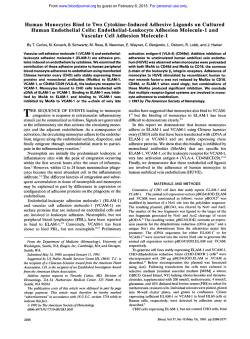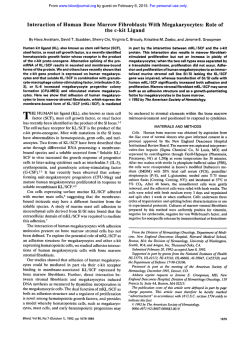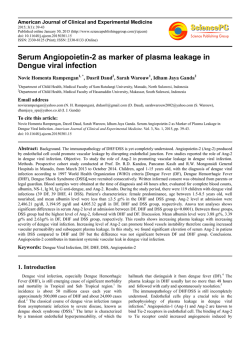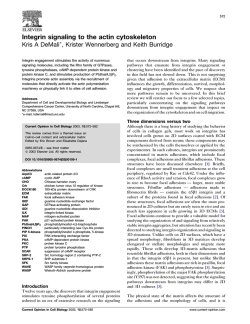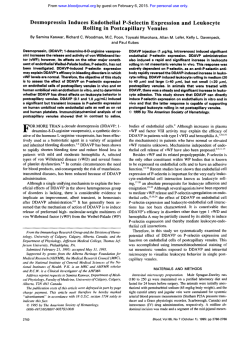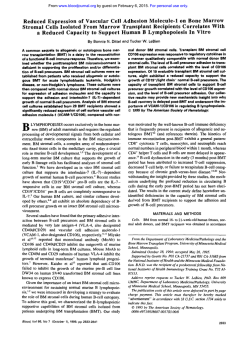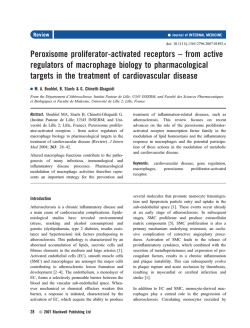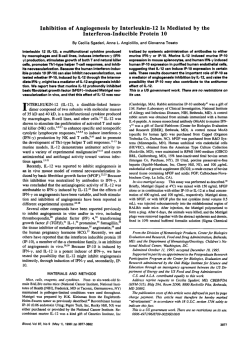
Vascular cell adhesion molecule
American Journal of Life Sciences 2015; 3(1): 22-26 Published online January 30, 2015 (http://www.sciencepublishinggroup.com/j/ajls) doi: 10.11648/j.ajls.20150301.15 ISSN: 2328-5702 (Print); ISSN: 2328-5737 (Online) Vascular cell adhesion molecule-1 and endothelial leukocyte adhesion molecule-1 as markers of atherosclerosis of NIDDM Mohammed E. Al-Ghurabi, Ali A. Muhi, Dhefaf H. Al-Mudhafar Department of biology, College of Science, University of Kufa, AL- najaf, Iraq Email address: [email protected] (M. E. Al-Ghurabi), [email protected] (A. A. Muhi), [email protected] (D. H. Al-Mudhafar) To cite this article: Mohammed E. Al-Ghurabi, Ali A. Muhi, Dhefaf H. Al-Mudhafar. Vascular Cell Adhesion Molecule-1 and Endothelial Leukocyte Adhesion Molecule-1 as Markers of Atherosclerosis of NIDDM. American Journal of Life Sciences. Vol. 3, No. 1, 2015, pp. 22-26. doi: 10.11648/j.ajls.20150301.15 Abstract: Background: Leukocyte adhesion to arterial endothelial cells is thought to be an important step in the development of atherosclerosis, Adhesion molecules such as vascular cell adhesion molecule-1 (VCAM-1) and the endothelial-leukocyte adhesion molecule-1 (ELAM-1) play an essential role in the early stages of atherogenesis of diabetic patients. Materials and Methods: The study was conducted on 80 male divided into two groups 60 of them had diabetes mellitus and 20 subjects were normal healthy individuals served as a control group. Enzyme linked immune sorbent assay (ELISA) was used for the measurement of serum VCAM-1and ELAM-1and WBC assay executed by automatic hematology analyzer the information of patients were obtained through a questionnaire consisted Patients with other diseases were excluded from the current investigation. Results: This result revealed elevated level of serum VCAM-1and ELAM-1 of Diabetes patients compared with healthy group also differentiation count reveal elevated count of WBC, Neutrophil, Lymphocyte, Monocyte, Eosinophil, Basophil in Diabetes patient as compare with HT group. Keywords: ELAM-1, VCAM-1, NIDDM 1. Introduction Accelerated atherosclerosis and microvascular disease are the major vascular complications of diabetes, and constitute the principal cause of morbidity and mortality in this ubiquitous disorder.[1,2,3] Many underlying factors could contribute to this outcome, including abnormalities in plasma lipoproteins, blood pressure, and renal function. A final common pathway in the development of vascular pathology is the expression of inducible adhesion molecules rendering the vasculature a selective target for circulating peripheral blood cells. In this context, vascular cell adhesion molecule-1 (VCAM-1)' is of particular interest as its expression has been linked to the early phase of experimental hypercholesterolemia-induced atherosclerosis [4,5], and enhanced vascular VCAM-1 expression has been demonstratedin the vasculature of alloxan-treated diabetic rabbits [6] as well as in human atherosclerotic lesions [7]. It is well known that soluble intercellular adhesion molecule-1 (sICAM-1), soluble VCAM-1 (sVCAM-1) levels are elevated in patients with type 2 diabetes [8,9,10]. Previous studies suggest that hyperglycemia, hyperinsulinemia, or insulin resistance may be responsible for the elevation of adhesion molecules[11,12]. Adherence of circulating leukocytes to endothelium and their subsequent transmigration in to the arterial intima is an early step in the formation of atherosclerotic lesions[13]. The recruitment of leukocytes in to tissues is dependent on a cascade of events mediated through a diverse family of cellular adhesion molecules that are expressed on the surface of vascular endothelial cells [14,15]. Membrane-bound VCAM-1 is expressed mainly on endothelial cells, smooth muscle cells, and tissue macrophages [16,17], and allows the tethering and rolling of monocytes and lymphocytes, as well as firm attachment and transendothelial migration of leukocytes [18,19,20]. Endothelial expression of VCAM-1 occurs on human atherosclerotic plaques [7,21] and has been shown to be an early manifestation of experimental cholesterol-induced atherosclerosis[4,17] American Journal of Life Sciences 2015; 3(1): 22-26 Soluble forms (sVCAM-1) have been detected in plasma[22,23]. Secretion of sVCAM-1 is reported to be indicative of the expression of membrane-boundVCAM-1[24]. Although the physiological role of these soluble forms is unclear, it has been hypothesized that sVCAM-1 levels may serve as a monitor of expression of membrane-bound VCAM-1. Increased levels thus may reflect progressive formation of atherosclerotic lesions [25]. In addition, recent cross-sectional studies showed sVCAM-1 concentration to be positively associated with carotid artery intima-media thickness [26,27]. and with the severity of peripheral arterial disease assessed by angiography[28,29.30]. 2. Aims of the Study The aim of the study was to determine the level of Adhesion molecules and possible effect combined with leukocyte in atherogenesis of diabetes mellitus patients. 23 4. Statistical Analysis Data were analyzed using the software packages Graphpad prism for Windows (5.04, Graphpad software Inc. USA), Data are presented as the mean ± standard error (SE). The comparison between the patients and healthy groups were analyzed by one-way ANOVA and t-test. A p-value < 0.05 was considered significant 5. The Result 5.1. Relation between Vascular Cell Adhesion Molecule 1 (VCAM-1) of Diabetes Patients and Healthy Group Fig.1 shows comparison between Diabetes patients and healthy group. This result revealed the significant increased P<0.05 in serum (VCAM-1) 168±33 (ng/ml) of Diabetes patients compared with healthy group 63±12 (ng/ml). 3. Subjects and Methods The study was conducted on 80 male divided into two groups 60 of them had diabetes mellitus and the remaining 20 subjects were normal healthy individuals served as a control group. The patients were collected from the diabetic unit in Al-Sadder Medical City /Al-Najaf Al-Ashraf province during the period from July till November, 2013. Diabetes Mellitus was diagnosed by consultant doctors. The information of patients were obtained through a questionnaire consisted of the name, sex, age, weight, height. Patients with renal dysfunction, heart diseases, who were on drugs affect oxidative stress, i.e: antioxidants, antihy- perlipidemic agents were excluded from the current investigation. Blood samples were drawn by trained nurses or other health care professionals and divided in two tube first contain anticoagulant for biochemical measurements second tube left at room temperature for one hour to clotting, centrifuged 6000 rpm for 10 minutes, and then serum freezing at -20℃ to keep it stable for a few months, Enzyme linked immune sorbent assay (ELISA) was used for the measurement of serum VCAM-1and ELAM-1. Figure 1. Comparison between VCAM-1 of Diabetes patients and Healthy group. 5.2. Relation between Endothelial Leukocyte Adhesion Molecule 1 (ELAM-1) of Diabetes Patients and Healthy Group Fig.2 shows comparison between Diabetes patients and healthy group. This result revealed the significant increased P<0.05 in serum (ELAM-1) 53±8 (ng/ml) of Diabetes patients compared with healthy group 37±3 (ng/ml) 3.1. Automated Laboratory Methods 3.1.1. Serum Vascular Cell Adhesion Molecule 1 (VCAM-1) and Serum Endothelial Leukocyte Adhesion Molecule 1 (ELAM-1) Estimation This assessment employs a quantitative sandwich enzyme immunoassay technique, and performed by Automated microtiter plate ELISA reader (HumaReader HS, Cat.No.16670, Semi-automatic, microprocessor-controlled photometer, Wiesbaden. Germany). 3.1.2. WBC Differentiation Count Differential Count was performed by using CYANHemato analyzer (automatic hematology analyser. Catalog No. CY006, Cypress Diagnostics,Langdorpsesteenweg 160,B3201 Langdorp, Belgium.) Figure 2. Comparison between ELAM-1 of Diabetes patients and Healthy group. 5.3. Relation between White Blood Cells Counts of Diabetes Patients and Healthy Group The result in fig.3 shows comparison between Diabetes 24 Mohammed E. Al-Ghurabi et al.: Vascular Cell Adhesion Molecule-1 and Endothelial Leukocyte Adhesion Molecule-1 as Markers of Atherosclerosis of NIDDM patients and healthy group where as significant increased P<0.05of WBC, Neutrophil count, Lymphocyte count, Monocyte count, Eosinophil count, Basophil count in Diabetes patients 11632±3431, 5996±565, 4826±345, 489±89, 255±43, 66±26 (cell/mm3) as compare with HT group 8543±1432, 4533±139, 3483±276, 297±67, 187±36, 43±12 (cell/mm3) Figure 3. Comparison between White blood cells Counts of Diabetes patients and Healthy group. 5.4. Correlation between Vascular Cell Adhesion Molecule 1 and Endothelial Leukocyte Adhesion Molecule 1 of Diabetes Patients Group The result of fig.4 mark positive correlation between ELAM-1and VCAM-1 (R2 = 0.97) with statistical significant. Figure 4. Corelation between VCAM-1 and ELAM-1 of Diabetes patients. 6. Discussion The results of present study shown elevated level of VCAM-1and ELAM-1, this study in accordance with[31,24,32] whose said that elevated serum level of VCAM-1, an inducible cell-cell recognition protein on the endothelial cell surface (EC), has been associated with early stages of atherosclerosis. In view of the accelerated vascular disease observed in patients with diabetes, and the enhanced expression of VCAM-1 in diabetic patients, In the early stages of atherogenesis, Leukocyte adhesion to arterial endothelial cells is thought to be an important step in the development of atherosclerosis Adhesion molecules such as ICAM-1, VCAM-1 and the ELAM-1 play an essential role in this step.[33,34,35] Aggregations of lipid-rich macrophages and T lymphocytes can be demonstrated within the intima. The adhesion of leukocytes on endothelial cells and their transendothelial migration are mediated by adhesion molecules on the endothelial cell membrane that mainly belong to two protein families: the selectins and adhesion molecules of the immunoglobulin superfamily. For two members of the first group (E-selectin [ELAM-1] and Pselectin) and two members of the latter group (ICAM-1 and VCAM-1), expression has been demonstrated in various cell types forming the atherosclerotic plaque, for example, endothelial cells, vascular smooth muscle cells, and macrophages. Especially in intimal neovasculature, the expression of VCAM-1, ICAM-1, and ELAM-1 is upregulated[22,36]. Inflammatory cytokines modulate the homeostatic properties of the endothelium. Local inflammatory cells can generate and release cytokines which have the potential to activate endothelium, transforming its natural anti-adhesive and anti-coagulant properties, The inflammatory response generates cytokines which upregulate the expression of vascular cell adhesion molecules VCAM-1. Several reports support the notion that se- rum levels of VCAM-1 may be useful marker for providing information on atherogenesis , In animal and human models of atherosclerosis, the first sign of disease activity is an up-regulation of adhesion molecules such as VCAM-1. Endothelial dysfunction, a chronic state in which vasoconstrictive stimuli overcome vasodilative stimuli, is associated with insulin resistance from early stages of its development.[37,38,39,40,41] The present study demonstrated that the total and differential leukocyte counts were significantly altered in patients with hyperglycemia because of peripheral white blood cell (WBC) count has been shown to be associated with insulin resistance, type diabetes, coronary artery disease (CAD), stroke, and diabetes micro- and macrovascular complications. Peripheral blood leukocytes are com- posed of polymorphonuclear cells, including monocytes as well as lymphocytes. Polymorpho-andmononu- clear leukocytes can be activated by advanced glycation end products, oxidative stress, angiotensin II, and cytokines in a state of hyperglycemia. Leukocytes may be activated through the release of cytokines, such as tumor necrosis factor (TNF)[42,43,44,45]. 7. Conclusions This study indicates that elevated serum level of VCAM-1 and ELAM-1 associated with early stages of atherosclerosis in diabetes patients. References [1] Krolewski A, Warram J, Valsania P, Martin B, Laffel L, Christlieb A. Evolving natural history of coronary artery disease in diabetes mellitus. Am. J. Med 1991; 90:56S-61S. American Journal of Life Sciences 2015; 3(1): 22-26 [2] Factor S, Segal B, van Hoeven K. Diabetes and coronary vascular disease. Coron. Art. Dis 1991;3:4-10. [3] Nowak M1, Wielkoszyński T, Marek B, Kos-Kudła B, Swietochowska E, Siemińska L, et al. Blood serum levels of vascular cell adhesion molecule (sVCAM-1), intercellular adhesion molecule (sICAM-1) and endothelial leucocyte adhesion molecule-1 (ELAM-1) in diabetic retinopathy. Clin Exp Med 2008; 8(3):159-64. [4] Cybulsky M, Gimbrone M. Endothelial expression of a mononuclear leukocyte adhesion molecule during atherogenesis, Science. Wash. DC 1991;251:788-791. [5] Li H, Cybulsky M, Gimbrone M, Libby P.An atherogenic diet rapidly induces VCAM-1, a cytokine-regulatable mononuclear leukocyte adhesion molecule, in rabbit aortic endothelium. Arterioscler. Thromb 1993;13:197-204.. [6] [7] [8] [9] Richardson M, Hadcock S, DeReske M, Cybulsky M. Increased expression in vivo of VCAM-1 and E-selectin by the aortic endothelium of normolipemic and hyperlipemic diabetic rabbits. Arterioscler. Thromb 1994;14:760-769. O’Brien KD, Allen MD, McDonald TO, Chait A, Harlan JM, Fishbein D, et al. Vascular cell adhesion molecule-1 is expressed in human coronary atherosclerotic plaques: implicationsfor the mode of progression of advanced coronary atherosclerosis, J ClinI n v e s t 1993;92:945–951. Fasching P, Waldhausl W, Wagner O. Elevated circulating adhesion molecules in NIDDM; potential mediators in diabeticmacroangiopathy, Diabetologia 1996;39:1242-1244. Albertini JP, Valensi P, Lormeau B,Aurousseau MH, Ferriere F, Attali JR,Gattegno L. Elevated concentrations ofsoluble Eselectin and vascular cell adhesion molecule-1 in NIDDM: effect of intensiveinsulin treatment.Diabetes Care 1998;21:1008–1013. [10] Kado S, Wakatsuki T, Yamamoto M, Nagata N. Expression of ICAM-1 induced by high glucose concentrations in human aortic endothelial cells. Life Sci 2001;68: 727-737. [11] Morigi M, Angioletti S, Imberti B, DonadelliR, Micheletti G, Figliuzzi M, et al.Leukocyte-endothelialinteraction is augmented by high glucoseconcentrations and hyperglycemia in aNF-kB-dependent fashion. J Clin Invest 1998;101:1905– 1915. [12] Matsumoto K, Miyake S, Yano M, Ueki Y,Tominaga Y. High serum concentrationsof soluble E-selectin in patients with impairedglucose tolerance with hyperinsulinemia. Atherosclerosis 2000;152:415–420. [13] Yong Woo Lee, Paul H. Kim, Won Hee Lee, Anjali A. Interleukin-4, Oxidative Stress, Vascular Inflammation and Atherosclerosis. Biomol Ther 2010;18(2): 135–144. [14] Albelda SM, Smith CW, Ward PA. Adhesion molecules and inflammatory Injury, FASEB J 1994;8:504–512. [15] Springer TA. Adhesion receptors of the immune system, N a t u r e 1990;346 : 425 – 434. [16] O’Brien KD, McDonald TO, Chait A, Allen MD, Alpers CE. Neovascular expression of E-selectin, intercellular adhesion molecule-1, and vascular cell adhesion molecule-1 in human atherosclerosis and their relation to intimal leukocyte content. C i r c u l a t i o n 1996;93:672–682. 25 [17] Libby P, Li H. Vascular cell adhesion molecule-1 and smooth muscle cell activation during atherogenesis, J Clin Invest 1993;92:538–539. [18] Alon R, Kassner PD, Carr MW, Finger EB, Hemler ME, Springer TA. The integrin VLA-4 supports tethering and rolling in flow on VCAM-1, J Cell Biol 1995;128:1243–1253. [19] Luscinskas FW, Kansas GS, Ding H, Pizcueta P, Schleiffenbaum BE, Tedder TF, Gimbrone MA Jr. Monocyte rolling, arrest and spreading on IL-4-activated vascular endothelium under flow is mediated via sequential action of L-selectin,beta 1-integrins, and beta 2-integrins, J Cell Biol 1994;125:1417–1427. [20] Jager A, van Hinsbergh VW, Kostense PJ, Emeis JJ, Nijpels G, Dekker JM, et al.Increased levels of soluble vascular cell adhesion molecule 1 are associated with risk of cardiovascular mortality in type 2 diabetes, the Hoorn study, Diabetes 2000;49(3):485-91. [21] Davies MJ, Gordon JL, Gearing AJ, Pigott R, Woolf N, Katz D, et al. The expression of the adhesion molecules ICAM-1, VCAM-1, PECAM, and E-selectin in human atherosclerosis, J Pathol 1993;171:223–229. [22] Gearing AJ, Hemingway I, Pigott R, Hughes J, Rees AJ, Cashman SJ. Soluble forms of vascular adhesion molecules, E-selectin, ICAM-1, and VCAM-1:pathological significance, Ann N Y Acad Sci 1992;667:324–331. [23] Gearing AJ, Newman W. Circulating adhesion molecules in disease, Immunol To d a y 1993;14:506–512. [24] Schmidt AM, Hori O, Chen JX, Li JF, Crandall J, Zhang J, et al. Advanced glycation endproducts interacting with their endothelial receptor induce expression of vascular cell adhesion molecule-1 (VCAM-1) in cultured human endothelial cells and in mice: a potential mechanism for the accelerated vasculopathy of diabetes, J Clin Invest 1995;96:1395–1403. [25] Jang Y, Lincoff AM, Plow EF, Topol EJ. Cell adhesion molecules in coronary artery disease, J Am Coll C a r d i o l 1994; 24:1591–1601. [26] Kawamura T, Umemura T, Kanai A, Uno T, Matsumae H, Sano T, et al. The incidence and characteristics of silent cerebral infarction in elderly diabetic patients: association with serumsoluble adhesion molecules, D i a b e t o l o g i a 1998;41:911–917. [27] Elżbieta Pac-Kożuchowska. Evaluation of lipid parameters, homocysteine, adhesion molecules and carotid intima-media thickness in children from families with circulatory system diseases history,the journal of preventive medicine 2004;12 (3-4): 5-14 [28] De Caterina R, Basta G, Lazzerini G, Dell’Omo G, Petrucci R, Morale M, et al.Soluble vascular cell adhesion molecule-1 as a biohumoral correlate of atherosclerosis, Arterioscler Thromb Vasc Biol 1997;17 : 26 46–2654. [29] Peter K, Nawroth P, Conradt C, Nordt T, Weiss T, Boehme M, et al.Circulating vascular cell adhesion molecule-correlates with the extent of human atherosclerosis in contrast to circulat- ing intercellular adhesion molecule-1, E-selectin, Pselectin, and thrombomodulin, Arterioscler Thromb Vasc Biol 1997;17:505–512, 1997. 26 Mohammed E. Al-Ghurabi et al.: Vascular Cell Adhesion Molecule-1 and Endothelial Leukocyte Adhesion Molecule-1 as Markers of Atherosclerosis of NIDDM [30] Farhan J Khawaja Iftikhar J Kullo. Novel markers of peripheral arterial disease, Vasc Med 2009;14(4): 381–392. [31] Shih-Jen Hwang, Christie M. Ballantyne, A. Richey Sharrett, Louis C. Smith, Clarence E. Davis, Antonio M. Gotto Jr, et al. Circulating Adhesion Molecules VCAM-1, ICAM-1, and Eselectin in Carotid Atherosclerosis and Incident Coronary Heart Disease Cases, Circulation 1997;96: 4219-4225. [39] Matsumoto K, Sera Y, Ueki Y Inukai G, Niiro E, Miyake S. Comparison of serum concentrations of soluble adhesion molecules in diabetic microangiopathy and macroangiopa- thy, Diabet Med 2002;19: 822–826. [40] Weissberg P. Mechanisms modifying atherosclerotic disease from lipids to vascular biology, Atherosclerosis 1999;147: 3– 10. [32] Altannavch TS, Roubalova K, Kucera P, Andel M. Effect of High Glucose Concentrations on Expression of ELAM-1, VCAM-1 and ICAM-1 in HUVEC with and without Cytokine Activation, Physiol. Res 2004;53: 77-82, 2004 [41] Ewa R, Jolanta J, Bronisława S, Celina W, Krzysztof S, Łukasz S, etal. Evaluation of VCAM-1 and PAI-1 concentration in diabetes mellitus patients, Diabetologia Doświadczalna i Kliniczna 2008;8:85-88. [33] Raja B Singh, Sushma A Mengi, Yan-Jun Xu, Amarjit S Arneja, Naranjan S Dhalla. Pathogenesis of atherosclerosis: A multifactorial process, Exp Clin Cardiol 2002;7(1): 40–53. [42] Ohshita K, Yamane K, Hanafusa M, Mori H, Mito K, Okubo M, etal. Elevated white blood cell count in sub- jects with impaired glucose tolerance, Di- abetes Care 2004;27:491–496. [34] Mach F. The role of chemokines in atherosclerosis, Curr Atheroscler Rep 2001;3:243–51. [43] Wei Xu1, Hai-feng Wu, Shao-gang Ma, Feng Bai, Wen Hu, Yue Jin, etal. Correlation between Peripheral White Blood Cell Counts and Hyperglycemic Emergencies, Int J Med Sci 2013;10(6):758-765. [35] Elena Galkina, Klaus Ley.Vascular Adhesion Molecules in Atherosclerosis. Arteriosclerosis, Thrombosis and Vascular Biology 2007;27: 2292-2301. [36] Matsumoto K, Sera Y, Nakamura H, Ueki Y, Miyake S. Serum concentrations of soluble adhesion molecules are related to degree of hyperglycemia and insulin resistance in patients with type 2 diabetes mellitus, Diabetes Res Clin Pract 2002;55: 131-138. [37] Rizzoni D, Porteri E, Guelfi D, et al. Endothelial dysfunction in small resistance arteries of patients with non-insulin-dependent diabetes mellitus. J Hypertens 2001; 19: 913–919. [38] Kowalska I, Strączkowska M, Szelachowska M. Circu- lating E-selectin, vascular cell adhesion molecule-1, and intercellular adhesion molecule-1 in men with coronary artery disease assessed by angiography and disturbances of carbohydrate metabolism, Metabolism 2002;51: 733–736. [44] Elyse D M, Stephen P G, Karin J D. Diabetes Alters Activation and Repression of Pro- and Anti-Inflammatory Signaling Pathways in the Vasculature, Front Endocrinol (Lausanne)2013;4: 68. [45] Ann Marie Schmidt, Osamu Hori, Jing Xian Chen, Jian Feng Li, Jill Crandall, Jinghua Zhang, etal.Advanced Glycation Endproducts Interacting with Their Endothelial Receptor Induce Expression of Vascular Cell Adhesion Molecule-1 (VCAM-1) in Cultured Human Endothelial Cells and in Mice, The Journal of Clinical Investigation 1995;96: 1395-1403.
© Copyright 2026
